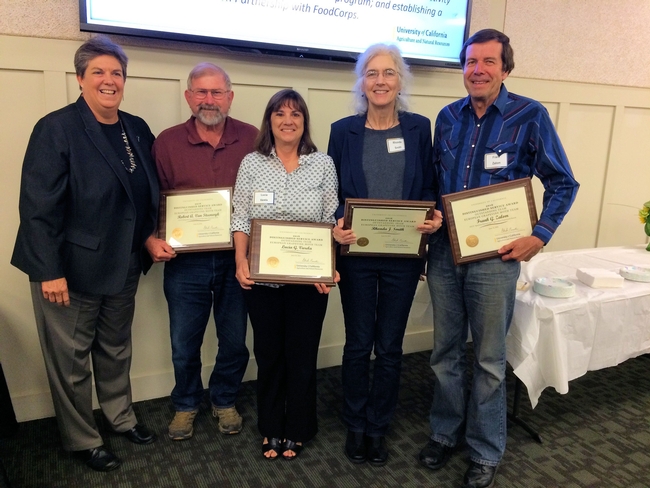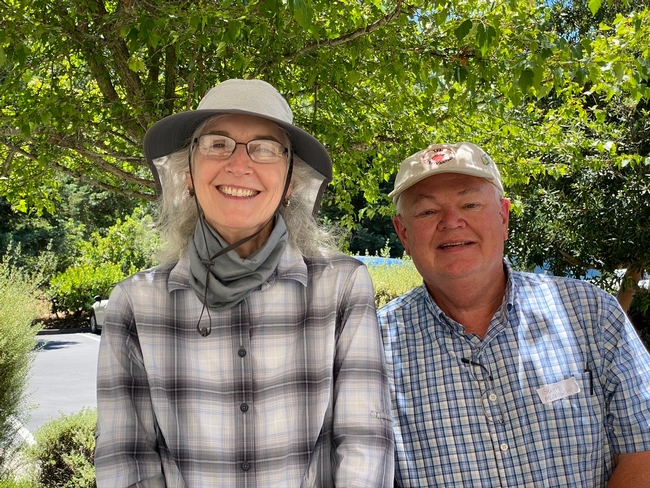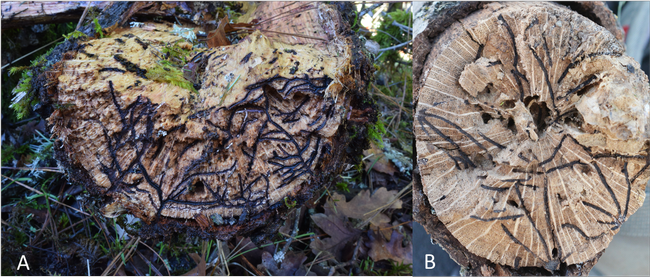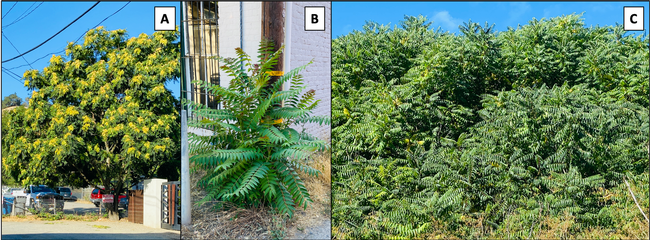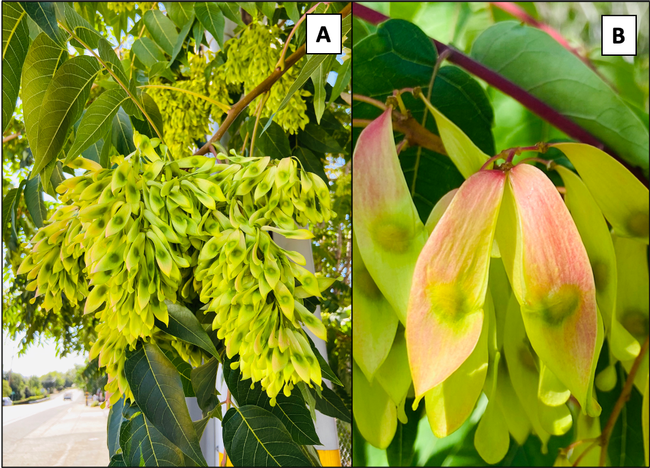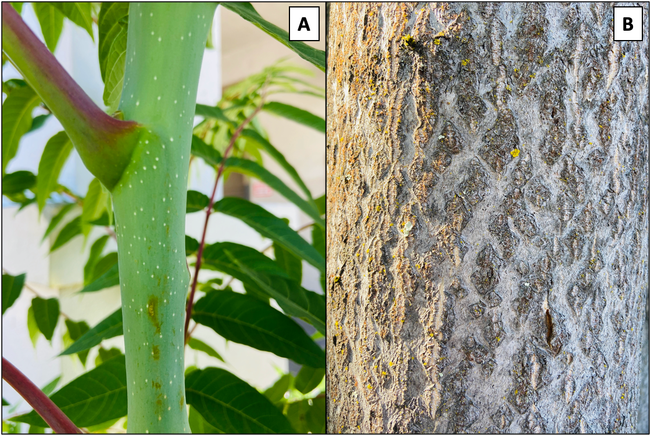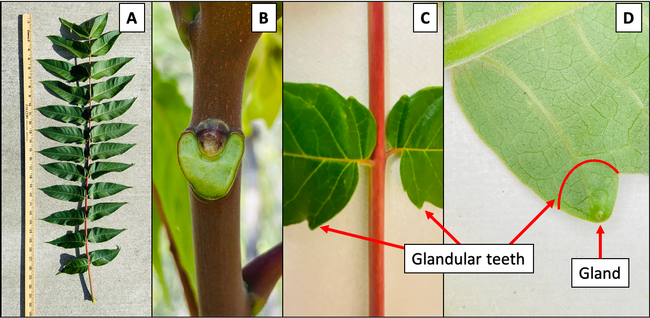- Author: Michael I Jones
by Michael I. Jones, PhD, UCCE Forest Advisor, Mendocino, Lake, & Sonoma County
As someone who has studied forest health for a while, I have developed the rather unfortunate habit of noticing only the red and brown canopies that appear in a sea of green (my wife says it makes visiting the forest with me rather depressing). Unfortunately, the tell-tale sign that a tree just died has become a common sight in the coastal forests over the past few years. While there is a suite of forest health issues (invasive species, fire suppression, and climate change to name a few) that are likely driving this decline and dieback, there is one that I am currently most concerned about: Drought.
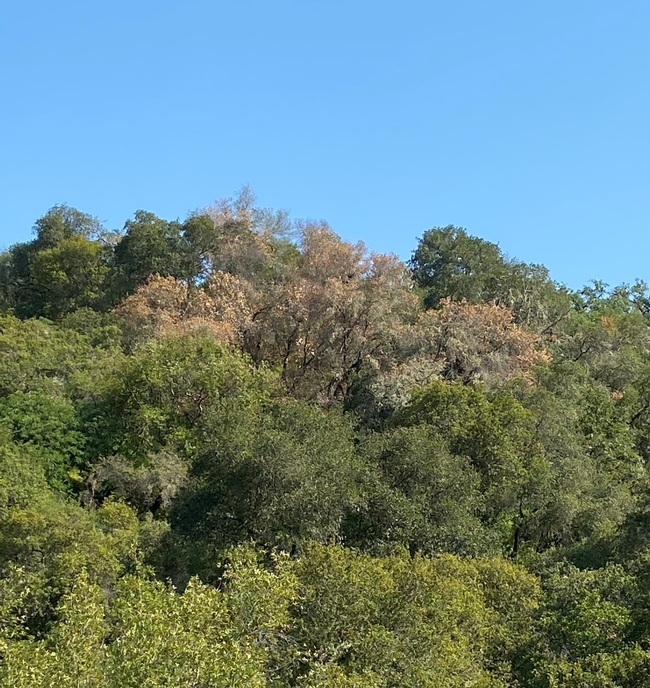
I noticed the first signs that drought stress was becoming an issue in early spring, when ponderosa pine began to die in eastern Mendocino County. Upon investigation, I found extensive western bark beetle and red turpentine beetle activity. I suspect the insects had established in fire stressed trees and their populations had built up over the past few years, to the point where they were spreading to trees that had no or little fire damage and into areas where there had not yet been wildfire. My colleagues and I have now observed ponderosa pine morality from northern Mendocino to northern Napa. It would seem we are at the initial stages of a western pine beetle outbreak, and I would suspect we will see a significant increase in pine mortality throughout the summer and into the next year.
Another conifer I have been getting questions about recently is Douglas-fir. Over the past few years there has been noticeable Douglas-fir decline and mortality, especially in young trees that have encroached into oak woodlands and rangeland. While this is an indication of unhealthy forests and stressed trees, I do not necessarily see this as a serious forest health issue since the expansion and growth of Douglas-fir in high densities into other habitats is the result of forest succession in the absence of fire. So, in my opinion the decline of some of these trees is a natural process resulting from the stress of growing on low quality sites and competing for water and nutrients, resulting in insect and disease infestations. Drought further increasing water stress and accelerates the rate of decline and dieback. However, I have yet to see extensive Douglas-fir mortality in high quality sites such as north facing slopes with moist, mild climates.
The next significant sign that drought stress was becoming an issue was the decline and mortality of interior live oak and CA Black oak in southern Mendocino County (Hopland). Upon investigating several clusters of declining trees, I found that the mortality was not associated with sudden oak death, but instead appeared to be caused by outbreaks of western oak bark beetle, a native bark beetle that is attracted to stressed trees. While many of the declining trees have extensive evidence of the bark beetle activity, several trees have only a few galleries, but were covered in cankers which are indicative of foamy bark canker, a disease caused by a pathogen the bark beetle vectors. While I have only observed this decline in the Hopland area, western oak bark beetle is found throughout California and could easily outbreak in other areas where oaks are highly drought stressed. Additionally, other native oak pests such as twig blight, branch canker, pit scale and invasive pests such as sudden oak death and Mediterranean oak borer are becoming more common in drought stressed trees throughout the Coastal Range.
What can we do about forest health and the drought? Many of the pests I mentioned are native and are simply acting as natural disturbances that help cull stressed and dying trees and begin the process of nutrient cycling. While eradicating pests or preventing them from infesting trees is extremely difficult, their populations can be controlled by pruning or removing and destroying heavily infested material. Suppressing insect and disease populations will not prevent all tree mortality but can help mitigate outbreaks that could spread to relatively healthy trees.
Thinning is another way to help the forest gain resiliency to drought. It can improve tree vigor through the reduction of competition and increase access to water and nutrients. But, when thinning is not an option, such as in an oak woodland or savannah and trees are still showing drought stress, then hopefully the drought adaptations these trees have evolved will be enough to help them survive.
For more information check out the UCCE Mendocino – Forest Health webpage at cemendocino.ucanr.edu. Also, feel free to contact me if you have questions, mjones@ucanr.edu or (707) 463-4495.
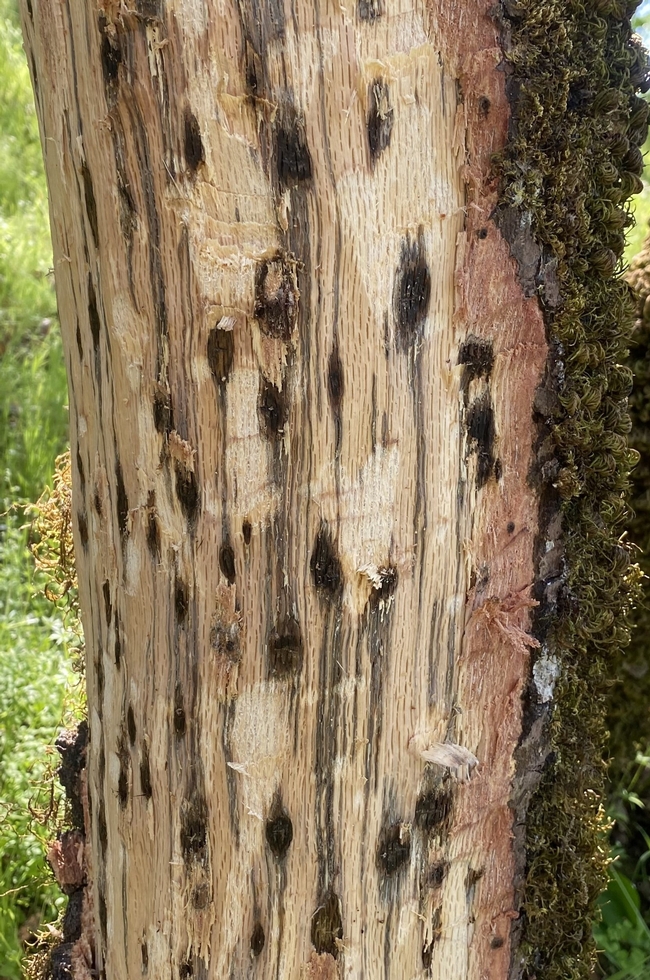
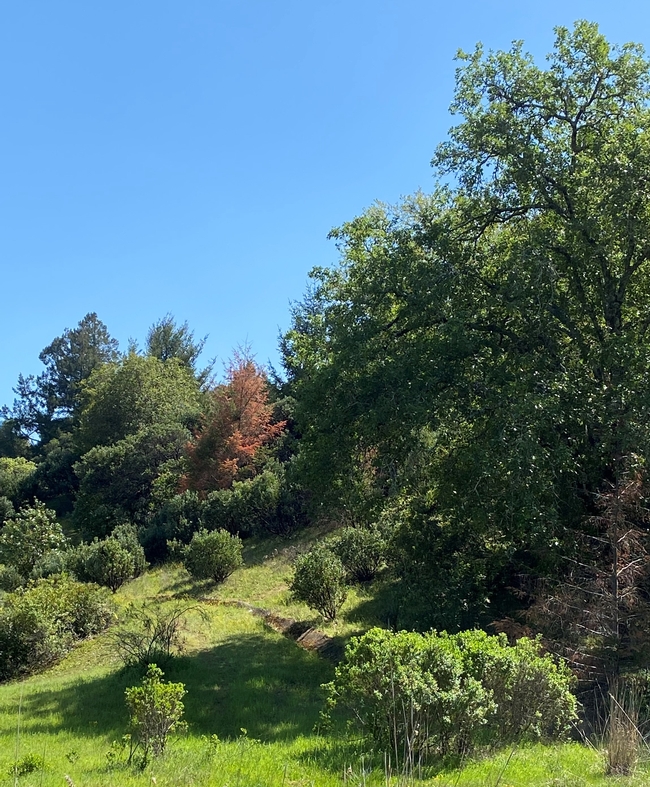
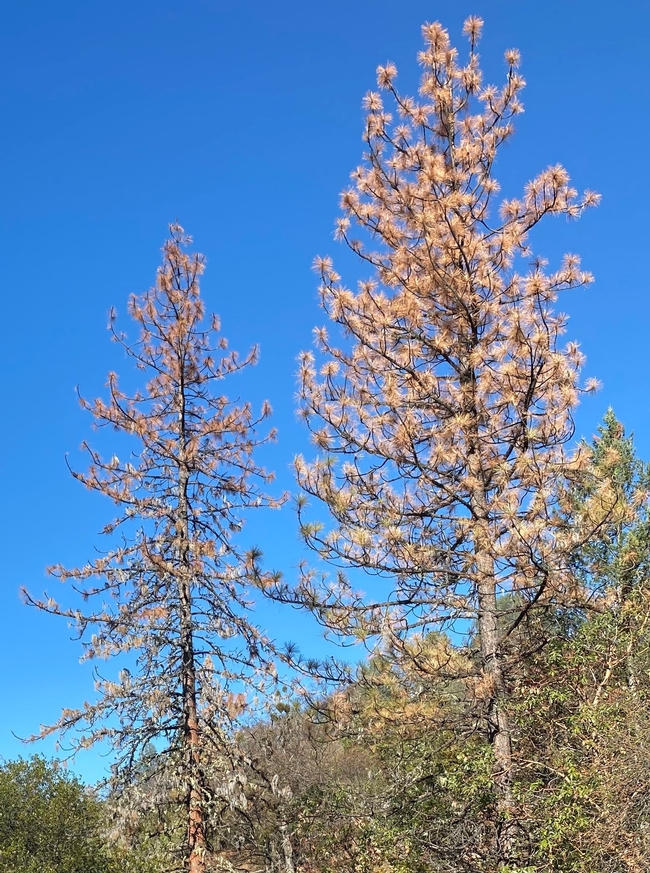
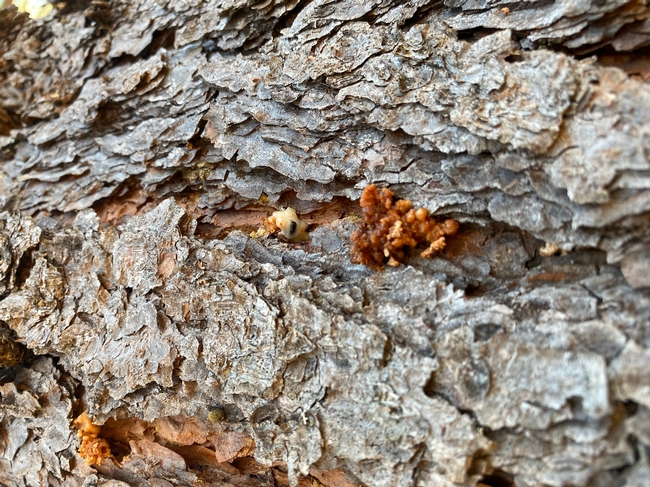
- Author: Michael I Jones
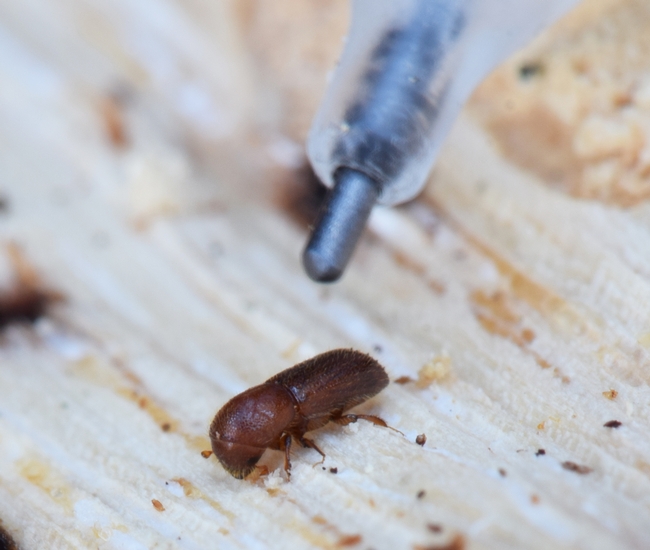
The Mediterranean oak borer (Xyleborus monographus), or MOB, is an invasive ambrosia beetle that was first collected from declining oak trees (Quercus spp.) near Calistoga (Napa County) in 2019 (Fig 1). Subsequently in early 2020, the beetle was detected in the neighboring counties of Lake and Sonoma, and more recently a separate infestation was discovered in suburbs near Sacramento. MOB is native to the Mediterranean regions of Europe, the Middle East, and North Africa and was likely introduced to North America in infested wood material. Within its native range MOB is a pest primarily of dead and dying oaks. In California, MOB has been detected in valley oak (Q. lobata) and blue oak (Q. douglasii). Given the cryptic nature of the insect, the extent of the infestations, and presence of dead trees with evidence of the beetle, the insect has likely been in California for more than five years.
Ambrosia beetles are interesting insects because they carry symbiotic ambrosia fungi which they cultivate along their galleries (boring tunnels) for food. Most ambrosia fungi are weak pathogens (typically only colonizing the tissue near the galleries), but a fungus associated with MOB, Raffaelea montetyi, appears to cause wilt disease in cork oaks in Portugal. This fungus and several others associated with MOB, have been recovered from infested trees in California and research is underway to determine if these ambrosia fungi could cause similar diseases in North American oak species.
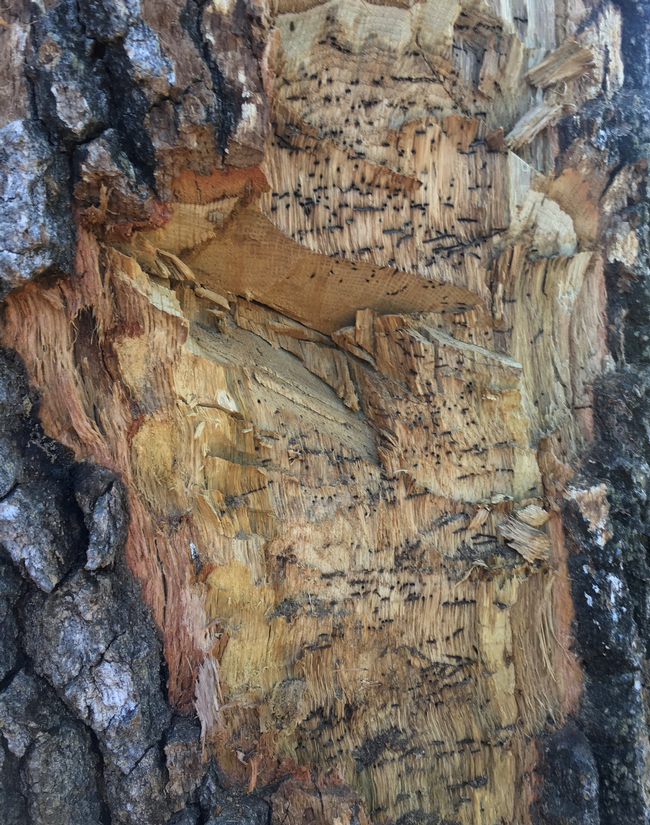
MOB appears to initially attack the canopy of host trees where it kills branches, with persistent infestations spreading to the main stem and eventually killing the tree (Fig. 2). The extensive network of MOB galleries can weaken trees and make them more susceptible to failure. Thus far, trees in California with MOB infestations appear to have been stressed by other biotic and abiotic factors prior to MOB colonization, so it is unclear if the insect and its ambrosia fungi can infest and kill healthy trees.
Signs of MOB infested trees are declining canopies, tiny exit holes and boring dust in cracks of the bark, and occasionally sap flux; however, these symptoms could be caused by other boring insects or diseases. The best way to detect MOB infested trees is to observe the pattern of canopy decline. MOB begins by colonizing a large branch in the upper canopy, so newly infested trees will often have one declining branch while the rest of the canopy appears healthy. As the infestation progresses, the entire canopy begins to decline and in some instances, heavily infested branches can produce extensive epicormic sprouting with leaves diminished in size and densely clustered (sometimes referred to as “popcorn foliage”). The most reliable way to confirm MOB is from the architecture of its galleries, which are trellis-like, intersecting, and fan out in a single plane (Fig. 3A). These gallery patterns distinguish it from native Monarthrum spp. of ambrosia beetles, which have galleries branching from a single point and do not intersect neighboring galleries (Fig. 3B). These native beetles will only attack trees that are already dead, dying, or diseased.
Research is currently underway to determine the extent of the two infestations and to find effective management strategies to control MOB. From other similar invasive insects, such as the shot hole borer in southern California, options like chipping (≤1” size), solarization, burning, or burying infested material will likely be crucial in mitigating spread. However, since infestations can be cryptic for several years, there is significant potential for the beetle's range to expand as they can be moved in infested wood and are capable fliers. The best method of control is preventing the movement of the insect and its host material from known infested areas. For more information, please visit: ucanr.edu/sites/mobpc.
If you have a tree that you believe to be infested, please contact the California Department of Food and Agriculture:
- Pest Hotline: 1-800-491-1899
- Report a Pest: cdfa.ca.gov/plant/reportapest/
Michael I. Jones, PhD, UC Cooperative Extension Forest Advisor, Mendocino, Lake, & Sonoma County, mjones@ucanr.edu, (707) 463-4495
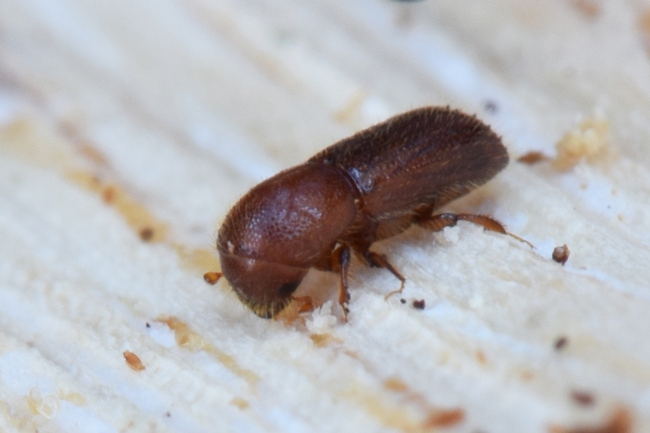
- Author: Cindy Kron
Invasive tree-of-heaven is a preferred host for two invasive insect pests that cause economic damage in California agricultural crops
It is not uncommon for commercial agriculture to share a common boundary with riparian, forested or urban areas in California. Some pest species thrive in these border areas and serve as a source of insect pest pressure on neighboring commercial crops. Invasive species that find preferred hosts in these border areas can be especially problematic in that their new environment lacks the predators from their native habitat that would normally suppress and keep their population manageable. This uncontrolled population growth can result in significant economic damage to nearby commercial crops.
The tree-of-heaven (TOH), Ailanthus altissima, is an invasive tree that has been documented in 45 states including California. This deciduous tree can be found in agricultural, urban, riparian and disturbed forested areas (Fig. 1A, 1B). This tree serves as a preferred host of two invasive species: the brown marmorated stink bug (BMSB), Halyomorpha halys, and the spotted lanternfly (SLF), Lycorma delicatula.
In California, BMSB is established in 16 counties and detected in 23 additional counties. The brown marmorated stink bug has over 170 host species (fruit, nuts, vegetables, and ornamentals) including the following agricultural crops: grape, pear, apple, stone fruit, citrus, blueberry, raspberry, blackberry, fig, almond, hazelnut, sunflower, sweet corn, soybean, okra, bell pepper, green bean, tomato, and eggplant. To date, in California, BMSB has been observed causing damage in commercially grown almond, apple, peach, and pear orchards.
The SLF has been recorded in 6 East Coast states but has not yet been documented in California. This insect lays eggs on plant and nonplant items such as stones, pallets, outdoor furniture, railway cars, firewood, and vehicles, which contributes to their wide dispersal ability and their likelihood of unintentional introduction into California. The SLF has at least 40 host species (fruit, nuts, ornamentals, and woody trees) found in North America including the following agricultural crops: grape, stone fruits, apple, blueberry, fig, hops, walnut, and almond.
BMSB and SLF share some similarities. Both are native to China, introduced into the U.S. via Pennsylvania, cause economic damage in a range of commercial crops found in California, and aggregate in large numbers. The tree-of-heaven is a preferred host.
In addition to supporting the growth of economically damaging insect pests, the tree-of-heaven has its own impacts on the ecology of areas where they establish. The tree-of-heaven competes with native plants and trees by releasing allelopathic chemicals that prevent the establishment and inhibit the growth of native trees nearby (Fig. 1C). The tree has a rapid growth rate of 3 to 6 feet a year and is able to start bearing seeds within 2 to 3 years. Female trees can produce more than 300,000 seeds (Fig. 2A) that are easily dispersed by the wind allowing for new trees to establish some distance from the parent tree. Established trees can also spread by sending up root suckers up to 50 feet from the parent tree. In addition, small root fragments can also generate new shoots. An injured or cut tree-of-heaven responds by producing numerous root sprouts that allows the tree to spread prolifically and complicates efforts to remove the invasive tree. The tree-of-heaven is a high pollen producer aggravating those with allergies. Direct contact can cause skin irritation and, in rare cases, inflammation of the heart muscle has been documented from exposure to sap through broken skin. These features of tree-of-heaven fuels its ability to invade new environments and makes it very difficult to remove after it has become established.
Being that the tree-of-heaven is invasive and also supports two invasive insect pests that are known to cause economic damage in a range of commercial agriculture crops grown in California, it is important for the agriculture industry to become familiar with how to identify the tree-of-heaven. This knowledge can be used to increase the awareness of the proximity of these trees to host crops that you work with, manage or own. Calculated management decisions can then be made from this information.
The tree-of-heaven is similar in appearance and can easily be confused with a handful of native tree species: black walnut (Juglans nigra), winged/shining sumac (Rhus copallina), ash (Fraxinus spp.), staghorn sumac (Rhus typhina) and butternut walnut (Juglans cinerea). Young tree-of-heaven have greenish smooth bark (Fig. 3A) that turns a greyish-brown in older trees resembling the skin of a cantaloupe (Fig. 3B). Leaves have a central stem with 10 to 40 leaflets attached on each side by a short petiole (Fig. 4A). A V-shaped or heart-shaped scar is noticeable when a leaf is broken off of the main stem (Fig. 4B). The margins of the leaflets are smooth with one to two bumps called glandular teeth that protrude at the base of each leaflet near the petiole (Fig. 4C). A corresponding gland is located on the underside of the leaflet where the glandular teeth are located (Fig. 4D). A strong odor described as cat urine, rancid cashews or burnt peanut butter is given off when the leaves or stems are crushed. Twigs break easily exposing a brown spongy pith. Tree-of-heaven are dioecious with separate male and female trees. Female trees produce red, yellow and green “samaras” that each contain one seed covered by a winged and papery tissue used in wind dispersal (Fig. 2B).
Agricultural land and nearby areas should be inspected for existing tree-of-heaven stands. There are different strategies that can be followed upon identifying this tree in or near farmed land. The first strategy is to use the tree-of-heaven as a sentinel tree that is visually inspected periodically for the presence of BMSB and SLF life stages during the growing season. This would be an easy and ideal option if either invasive pest is not reported in your county or nearby counties. Early detection can help prevent establishment in your county and the economic damage that these invasive species cause in commercial crops. Any sightings or insect samples should be submitted to your local county agricultural commissioner's office.
A second strategy could be used if detections of either invasive species have occurred in your county or local area. Traps for BMSB monitoring can be deployed using a double-sided sticky panel with a dual lure and placed near the tree-of-heaven. If SLF were to arrive in California, brown sticky bands wrapped around the trunks of tree-of-heaven can capture the immature stages as they engage in their typical behavior of walking up the tree. Trap finds can alert growers of an invasive species presence in an agricultural field and treatment decisions can then be made.
A third strategy would be to remove tree-of-heaven, but this comes with a warning: mowing or cutting, by themselves, are ineffective and can cause the tree to spread prolifically. Care needs to be taken when deciding to remove tree-of-heaven since a cut tree responds by sending up numerous root sprouts up to 50 feet from the parent tree. Timing of treatment and commitment to follow up with subsequent treatments the following year are crucial for success. If tree removal is the decision made, the root system should be targeted with a systemic herbicide 30 days before cutting the trees and the application needs to be made between July and mid-October when carbohydrates are being allocated to the root system. If an herbicide is applied outside of this range, the application would likely be ineffective due to targeting the above ground growth and not the root system. Gloves, long-sleeved shirts and pants should be worn during tree removal to prevent the contact of tree parts and sap with the skin. Follow-up monitoring is needed to determine the need and timing of additional treatment applications.
- Author: IPM Program
- Contributor: Karen Giovannini
Author: UC Integrated Pest Management Program
Have you had unexpected seeds show up in the mail? Unknown seeds could be invasive plants, contain invasive insects, or have plant disease causing agents. Here's what the United States Department of Agriculture Animal Plant and Health Inspection Service (USDA APHIS) has to say about it. APHIS Stakeholder Announcement July 28, 2020 (Language from their website)
USDA Investigates Packages of Unsolicited Seeds
USDA is aware that people across the country have received suspicious, unsolicited packages of seed that appear to be coming from China. USDA's Animal and Plant Health Inspection Service (APHIS) is working closely with the Department of Homeland Security's Customs and Border Protection, other federal agencies, and State departments of agriculture to investigate the situation.
At this time, [USDA does not] have any evidence indicating this is something other than a “brushing scam” where people receive unsolicited items from a seller who then posts false customer reviews to boost sales. USDA is currently collecting seed packages from recipients and will test their contents and determine if they contain anything that could be of concern to U.S. agriculture or the environment.
USDA is committed to preventing the unlawful entry of prohibited seeds and protecting U.S. agriculture from invasive pests and noxious weeds. Visit the APHIS' website to learn more about USDA's efforts to stop agricultural smuggling and promote trade compliance.
What to do with the Seeds
Do NOT plant or dispose of these seeds!
Please hold onto the seeds and packaging, including the mailing label.
In Sonoma County
Anyone who receives an unsolicited package of seeds can drop the seeds and packaging off in the Drop Box at the Agriculture Department, 133 Aviation Blvd, Santa Rosa CA 95403 or contact the department:
- SonomaAg@Sonoma-County.org
- 707-565-2371
Other Counties
Contact your County Agriculture Commissioners office.
Best Practices: do not plant seeds from unknown origins
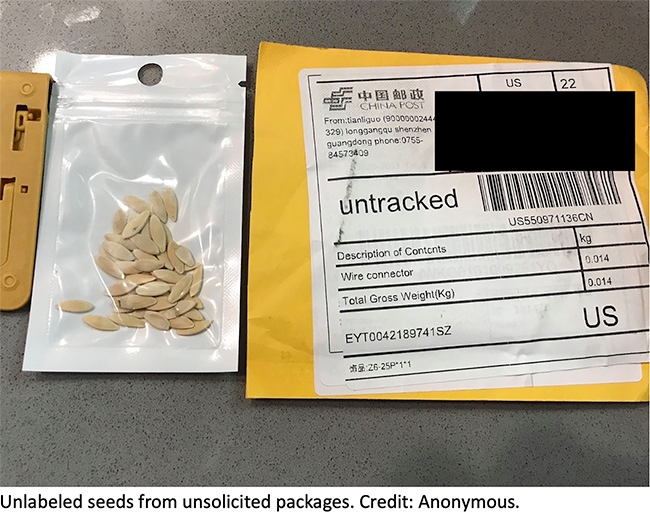
Smith described as icon and heroine for work in advancing wine grape production

A scientist first and foremost, Rhonda steadily emerged as Sonoma County's resident expert on all things wine grape during her nearly 34 years as the viticulture advisor for the University of California Cooperative Extension. Over the decades, she used her scientific know-how, meticulous research methodology and incredible work ethic to advance wine grape production in Sonoma County.
She cultivated real working relationships with growers and vineyard managers during her time setting up field trials and collecting data in vineyards throughout Sonoma County. As the years rolled by, she earned the respect and admiration of grape growers who wonder what they will do without her as she leaves her longtime post and heads into retirement.
“Rhonda Smith became a true icon in Sonoma County viticulture for her timely research and her effective way of communicating valuable information to the wine grape industry,” said grower Bob Dempel of Santa Rosa.
Tito and Janet Sasaki who farm wine grapes in the Sonoma Valley are among the growers who have benefited from Rhonda Smith's dedication to the wine grape industry. The Sasakis said Rhonda is continually studying the latest developments in viticulture science but is always ready to be in the field to help growers – often at a moment's notice when a new problem crops up.
“Rhonda Smith is the quiet heroine of the vineyards in Sonoma County. She has been the family physician of Sonoma County vines for more than three decades,” said Tito Sasaki, past president of Sonoma County Farm Bureau and a longtime agriculture industry leader. He marvels at how Rhonda has managed the challenges of raising a family while coming to the rescue of growers facing problems like red blotch virus, vine mealybug, Pierce's disease and many other threats.
“Her serene and relaxed demeanor conceals the rock-solid strength of her dedication to others,” Tito said.
Said Janet Sasaki, “Rhonda is the hardest working person I know. My friends and I have been working with her since 1989. No vineyard is too small for her to take an interest in the problem. She is very respected by everyone in the wine grape industry.”
For her part, Rhonda, who is 66 and the mother of two grown children, said she has been fortunate to work in a field she loves, particularly, being able to focus so much of her time and energy on plant pathology, which has intrigued her since her days as a student at the University of California, Davis. She was inspired by professors and Cooperative Extension farm advisors who used scientific research to find ways to combat the diseases that were impacting agriculture and causing economic losses to farmers.
Becoming the viticulture advisor in Sonoma County gave her the opportunity to do the research she loved while providing the best possible opportunities for growers to thrive and produce the world class wines that have made Sonoma County famous. She said her goal has always been to assist the industry in successfully navigating the delicate balance between grape quality and economically acceptable crop yields – the essential combination to prosper as a premium grower of wine grapes.
“It's been fun and rewarding to be part of the Sonoma County wine industry for so many years,” said Rhonda, a resident of Windsor. Over the years she has been recognized with awards and accolades for her many contributions. In 2008 the Harvest Fair board of directors named her “Friend of Agriculture,” noting her hard work “to keep agriculture part of the Sonoma County landscape.”
Rhonda arrived in Sonoma County in 1986 to fill the UCCE viticulture advisor position held for many years by Robert Sisson, who had helped orchestrate Sonoma County's transition to premium varietals like chardonnay and cabernet sauvignon. It was a move that took Sonoma County from jug wine producer to a celebrated player on the world's wine stage.
Realizing the importance of maintaining quality and economic viability for Sonoma County's most important farming endeavor, Rhonda rolled up her sleeves and plunged into research and grower outreach to assist the viticulture industry as it faced continued new threats.
Shortly before starting as viticulture advisor, there was a crisis: vineyards throughout Sonoma and Napa counties were in decline, displaying lackluster vigor and sharp drops in yields. The culprit was phylloxera, a tiny insect that feeds on grapevine roots.
At that time, more than half the vineyard acreage in Sonoma and Napa counties was planted on a rootstock that had become susceptible to the insect pest. As a result, the majority of the vineyard acreage had to be replanted once severely infested with phylloxera.
Growers desperately needed a path forward. Rhonda and other scientists from UC Davis launched trials to evaluate the performance of alternative rootstocks for vineyards in the North Coast counties.
Through her rootstock trials, Rhonda was able to inform growers of the suitability of specific rootstocks in sites with heavy, cracking clay, wet soil conditions and high nematode populations.
Stephanie Larson, who is the director of UCCE in Sonoma County, said Rhonda Smith's targeted work on so many important issues epitomizes what a UCCE advisor should be – diligent and dedicated to finding solutions to growers' problems and channeling information and research from the University to the field. She said Rhonda's work spanned the spectrum from identifying the best rootstocks to coping with powdery mildew.
“Rhonda was a solid advisor who was extremely dedicated to the wine grape industry. She held UCCE Sonoma County Grape Day each year, without exception since 1987. Grape Day provided growers the most current information on issues such as pests, water, diseases, clones and rootstocks,” said Larson.
For 20 years Rhonda also coordinated the Sonoma County Vineyard Technical Group's nine monthly programs each year, working collaboratively with grower-members to select topics and speakers – including those from out of state - to bring research-based information that addressed farming practices and pest management applicable to the local industry.
“Throughout her career, Rhonda collaborated with state and local regulatory and resource agencies to provide expertise on issues that directly affect wine grape production,” Larson said.
Larson said Rhonda's retirement leaves a huge gap in viticulture knowledge and expertise for the industry. Unfortunately, she said, because of the state's current budget crisis, the UC Division of Agriculture and Natural Resources will not be filling Rhonda's position. But Larson said the University would entertain a discussion with the wine industry to hire a new viticulture advisor if the industry would fund half the cost of the position. She said there must be a five-year commitment for the funding.
Rhonda, who came from a military family, grew up in El Dorado Hills outside of Sacramento. She didn't have a farming background but early on knew she wanted to work outside, not in an office cubicle, after spending time at her uncle's walnut and hog ranch in Galt.
She went to UC Davis and in 1977 earned a bachelor of science degree in plant science, with an emphasis in plant pathology. In 1983 she completed a master's degree from Davis in horticulture, with an emphasis in viticulture.
Before taking the viticulture position in Sonoma County, she worked as a research associate for UC Davis, UCCE and the Department of Food and Agriculture in various parts of California.
Rhonda said her work in Sonoma County was more expansive and productive because of the tremendous cooperation of growers, vineyard managers and wine industry executives who provided vineyards and support for the field trials she conducted. She worked with dozens of vineyard industry professionals during her long career, often, bonding over mutual interests in chardonnay clones or vexed by the vagaries of Pierce's disease, caused by a bacterium spread by the blue-green sharpshooter.
Mark Lingenfelder, who was at Chalk Hill Estate Winery for many years, worked with Rhonda on a number of projects including chardonnay clonal studies and trials investigating the efficacy of a plant growth regulator to improve fruit set. Lingenfelder said because of Rhonda's expertise and professionalism it was a pleasure cooperating and collaborating on research trials that yielded valuable information that was shared with the viticulture industry.
“I was always amazed by Rhonda's energy, persistence and meticulous attention to detail. But she was not only a dedicated and tireless researcher. She was also a friendly, knowledgeable and patient advisor who was always incredibly generous with her time whenever I turned to her for advice,” said Lingenfelder. “We've had some great long conversations.”
Dana Grande, grower relations manager at Jordan Vineyard & Winery in Healdsburg, said she first met Rhonda Smith in 1994, a time when there were few women working in the viticulture industry.
“At that time, you could count the number of women in Sonoma County viticulture on one hand. Our relationship has always been one of mentorship – her to me - and it encompassed not only viticulture expertise, but how to carefully balance the career/mom life,” said Grande.
From 2002 to 2008 Grande worked with Rhonda on a study of berry shrivel in a cabernet sauvignon block, which was known as “Rhonda's Rows,” at Jordan. The collaboration forged a long, lasting relationship and mutual respect between the two viticulture professionals.
“I can't imagine what Sonoma County viticulture will look like without Rhonda Smith,” said Grande. “I and many others have relied on her advice, experience, and expertise for decades.”
In retirement, Rhonda plans to take a deep breath and then catch up on projects around the house and do some traveling. She will also have more time to spend with husband Dana and her grown children. Her daughter Emma, 29, is a US Air Force Captain and a Medical ICU nurse now preparing for her second deployment to the Middle East. Son Charles, 26, recently graduated from Chico State University with a degree in criminal justice and is seeking a job in law enforcement.
And at some point, Rhonda plans to sit back and reflect on her long and fruitful career while savoring Sonoma County wines.
Like many who appreciate wine, Rhonda is intrigued by the sensory elegance of what wine grapes become when entrusted to the hands of a masterful winemaker. “I appreciate the growers who provide wineries with the best fruit possible by making critical farming decisions driven by experience, knowledge and research based information.”
“Sonoma County has an ideal climate for growing wine grapes, but it is up to growers to establish then farm a vineyard with a balanced crop load, adequate soil moisture and canopies that maximize desired fruit composition. All that while managing pests, diseases and labor shortages.
I feel honored to have been able to work with
the people who are in this industry.”
Written by Tim Tesconi
